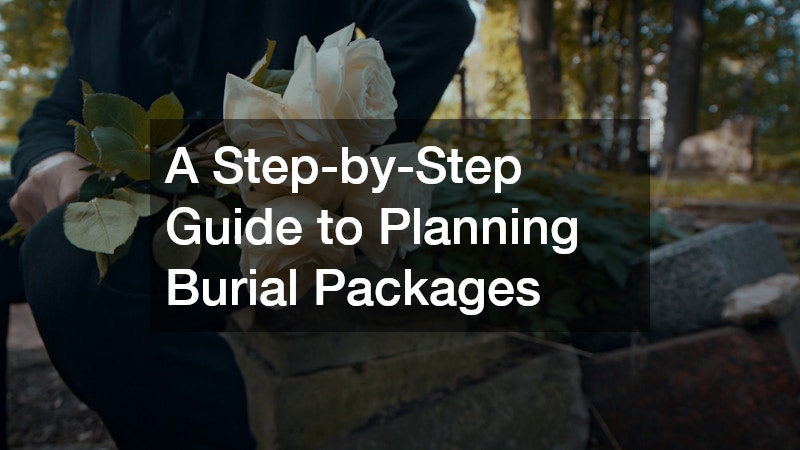Planning for the end of life is never easy, but it is one of the most thoughtful acts you can undertake for your loved ones. Making arrangements in advance ensures clarity, reduces emotional stress and helps manage financial obligations. Among the most critical elements to consider is the burial package. With various services available, understanding the steps involved in planning burial packages can simplify a complicated process and bring peace of mind.
Step 1: Understand Your Needs & Preferences
Before you begin exploring burial packages, it’s essential to understand the personal, cultural or religious needs associated with the burial. Every family has unique traditions and expectations when it comes to farewells and recognising these early helps narrow your options.
Consider whether you prefer a traditional burial, an eco-friendly alternative or an elaborate ceremony that reflects a person’s life achievements.
In addition to cultural and personal preferences, think about the practicalities such as location, cemetery requirements and transportation. Some families might prioritise a burial plot close to other loved ones, while others may focus on aesthetics or accessibility. Identifying these preferences at the start forms the foundation for a well-suited burial package.
Step 2: Set a Realistic Budget
Establishing a budget early in the planning process is vital. Burial packages can range significantly in cost, depending on the services included. Factors that influence price include the type of casket, plot location, funeral service arrangements and any added extras like floral tributes, music or printed materials.
It’s also helpful to determine whether you plan to pre-pay for the funeral or allow the estate to cover the costs later. Pre-paid burial packages offer financial certainty and lock in today’s prices, which can protect against inflation. A funeral director or financial advisor can assist in exploring payment options and determining what’s financially feasible without compromising on essential preferences.
Step 3: Choose a Funeral Provider
Selecting a reputable funeral provider is a crucial decision. A trusted funeral director offers guidance, support and transparency throughout the planning process. When choosing a provider, consider their reputation, experience and whether they offer flexible packages tailored to your needs.
Request a comprehensive breakdown of what’s included in each burial package and seek clarification on any unclear terms. Some providers may include headstones, grave opening and closing and coordination with cemetery staff, while others may offer these services as optional extras. Ask questions and ensure you fully understand the inclusions and exclusions before committing.
Step 4: Select Burial Site & Memorial Options
Choosing a burial site is a deeply personal decision and often ties into family heritage, religious affiliations or proximity for future visits. Whether you opt for a public cemetery, private plot or a natural burial ground, it’s essential to confirm availability and any site-specific regulations.
Once the location is determined, consider the type of memorial you would like. Traditional headstones, plaques or personalised monuments can be customised to honour the individual’s life. Ensure that your preferred style complies with cemetery guidelines and factor in any ongoing maintenance or fees associated with the site.
Step 5: Finalise Service Details
The burial service is the moment where family and friends gather to pay their respects, so it deserves careful consideration. Plan the sequence of events—whether it’s a religious ceremony, a secular celebration of life or a combination of both. Choose speakers, music, readings and other elements that reflect the personality and values of the deceased.
Work closely with your funeral provider to coordinate logistics such as transportation, officiants, seating arrangements and livestream options for distant attendees. Communicating your wishes clearly ensures the service runs smoothly and honours the life it commemorates.
Step 6: Prepare Documentation & Legal Arrangements
Legal documentation is a necessary part of burial planning. This includes death certificates, burial permits and agreements with cemeteries. If you’re arranging burial in advance, ensure your wishes are recorded in your will or other legally binding documents and share this information with your family or solicitor.
Ensure that all contracts with funeral providers and cemeteries are in writing and kept in a secure location. This documentation prevents misunderstandings and ensures that your chosen burial package is executed as intended.
Step 7: Communicate with Loved Ones
Perhaps the most important step in planning burial packages is communicating your decisions with those closest to you. Clear conversations now will ease the burden later. Let your family know where documents are stored, who to contact and the specifics of the arrangements.
If you’ve pre-paid or selected a package through a specific provider, share this information and provide their contact details. Open and honest discussions can reduce uncertainty and give everyone the reassurance that your wishes will be respected.
Thoughtful Planning Brings Peace of Mind
Taking the time to plan burial packages in advance reflects a deep level of care for the people you love. It helps to eliminate guesswork, manage emotional and financial stress and ensure a respectful farewell that aligns with personal values. While the process can be emotionally taxing, each step contributes to a meaningful and well-organised final tribute.
By approaching this task thoughtfully and with expert guidance, you provide a lasting gift to your family—one that honours your legacy while easing their future burden. Whether you’re planning for yourself or a loved one, starting the conversation today can make all the difference tomorrow.
.

